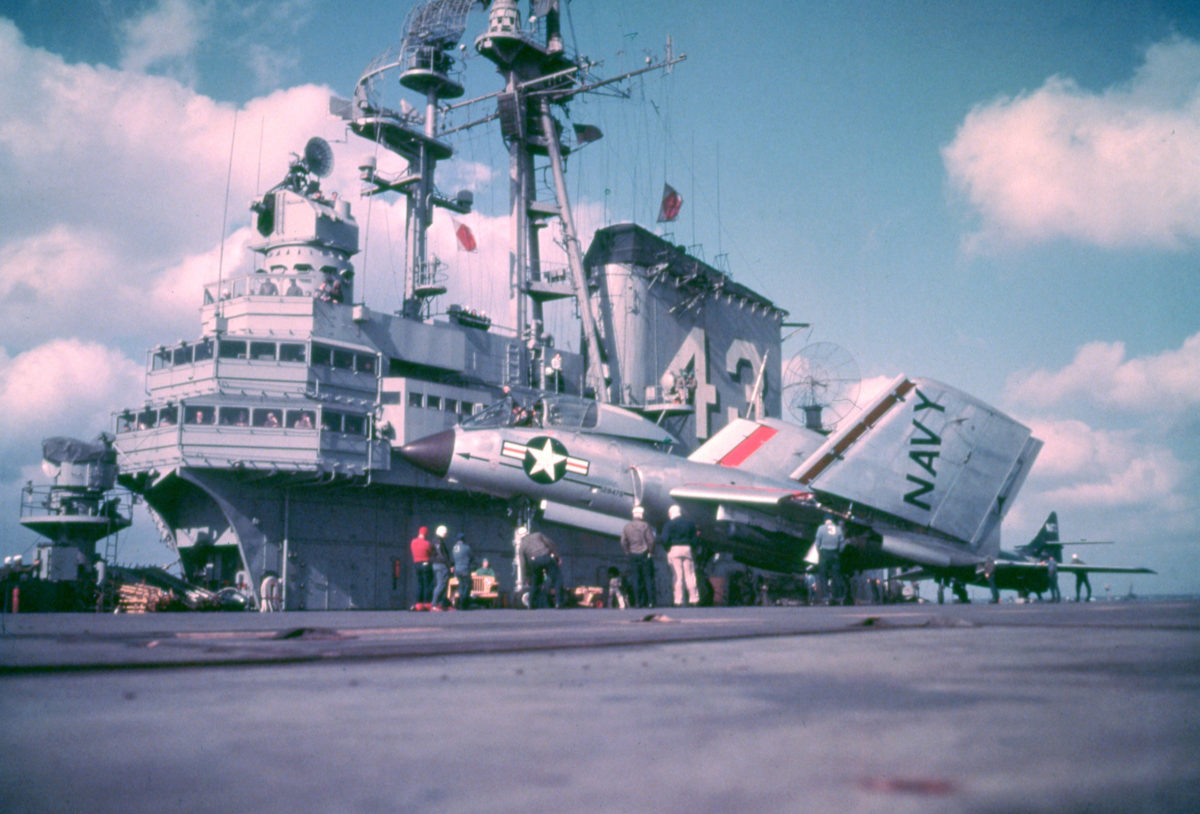When the Chance Vought F7U Cutlass first entered U.S. Navy service in July 1951, the tailless, sweptwing jet fighter seemed to represent a leap into the future.
The Shape of things to come
The Cutlass turned a lot of heads with its radical design, said to have been partially based on data captured from the Germans at the end of World War II. It was America’s first tailless production fighter, and the first airplane designed from the outset to use afterburners. The F7U featured hydraulically powered controls, an “artificial feel” control system and a steerable nose wheel. It was also the first fighter to catapult from a carrier with nearly 2½ tons of external stores and weapons.
The new Navy fighter’s prospects seemed bright, but various technical and handling problems conspired to cut its service career short. More than one-fourth of the 300-plus airframes built were destroyed in accidents, many of which were attributed to unreliable engines that generated insufficient thrust. In the end, the F7U would cost the Navy four test pilots and 21 regular pilots killed, earning it such uncomplimentary nicknames as “Gutless Cutlass” and “Ensign Eliminator.” Yet in the hands of a skilled pilot who was aware of its limitations, the sweptwing jet performed well, and some suggested that its failings could have been overcome with additional developmental work, as would be the case with Vought’s F8U Crusader.
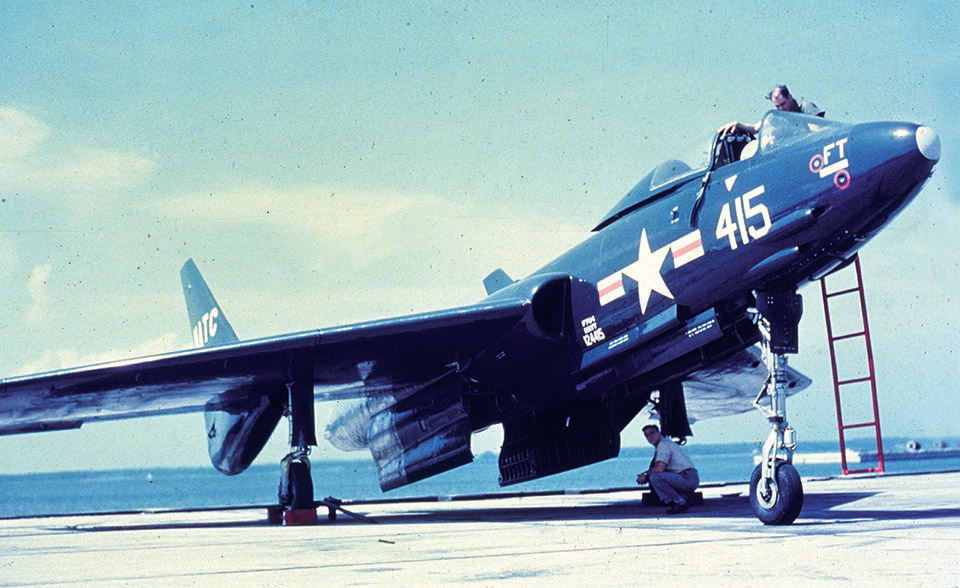
Vought began working on the design just a few weeks before World War II ended. Navy officials had issued a request for a fighter that could easily operate at 40,000 feet and reach speeds approaching Mach 1. The XFU-1 logged its first flight on September 29, 1948, and subsequent test flights yielded some impressive results. The Cutlass was capable of carrying two 2,000-pound bombs on its inner pylons or 1,000-pounders on the outer pylons. It could also carry up to four AAM-N-2 Sparrow air-to-air missiles and was armed with four 20mm cannons. Final testing showed that the F7U could haul its weight in ordnance for ground-attack missions, and would also be a viable threat in the air-to-air arena. As a result, the Navy placed an order for 14 F7U-1s.
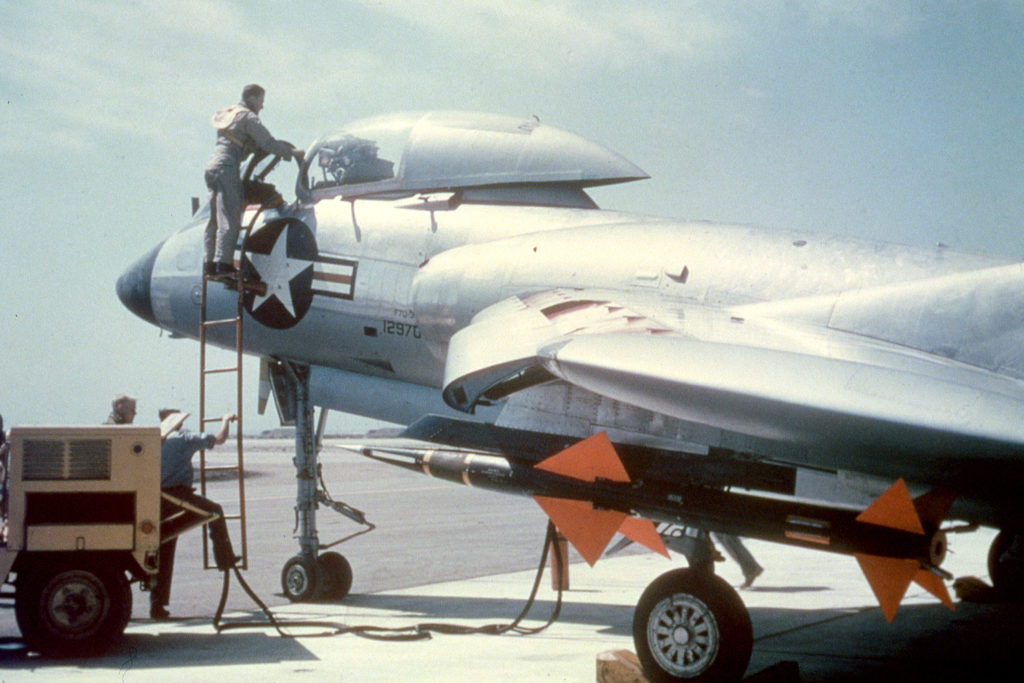
Lieutenant Don B. Shelton, who had flown F4U-5N Corsairs with Navy composite squadron VC-3 during the Korean War, was one of the most experienced pilots to fly the Cutlass. He was among the test pilots who took part in Project Cutlass at Naval Air Station Miramar in San Diego, gathering operational information prior to the improved F7U-3 joining the fleet. This elite group included Floyd Nugent, Van Biesbrock, Burt Shepherd, Don Christianson and future astronaut Wally Schirra. Commander James “Bud” Brown headed the project.Testing
The extensive test flights, during which the Cutlass’ many quirks were explored, demanded much of each pilot. Although the sweptwing fighter’s sleek look lent it irresistible allure, the F7U-3’s flying characteristics and overall performance resulted in some scary moments.
Testing uncovers flaws
Shelton initially flew in the Service Test (ST) unit that put some of the early dash-3s through their paces. “My first foray into the testing of the Cutlass was on April 2, 1953, right after I finished the classroom sessions,” he said. “It was F7U-3 Bu. No. 128461. I made two flights that day, and the next day I headed for Pax River [Naval Air Station Patuxent River, Maryland] in the same aircraft. It was one of the first production models, which meant it had the long ‘banana nose’ and the J35 engines that were in the first batch of 16 F7U-3s. The ones after that all had the J46 engines with afterburners. We had these aircraft for several months until there were several adjustments and modifications made to them. Once these changes were made, we were immediately back in the air.”
The ST unit’s job was to put as many service hours on the Cutlass as possible and assess its ability to be maintained during fleet operations. Shelton submitted a preliminary report right after leaving the ST that gave the F7U-3 a “thumbs-down” and strongly stated that early results indicated the fleet would be unable to satisfactorily maintain the aircraft. He received a lot of pressure from higher command to change the report, but he refused. Pax River’s flight test director, Commander Heber Badger, backed him up, and Shelton’s honest evaluations would later prove to be right on the mark.
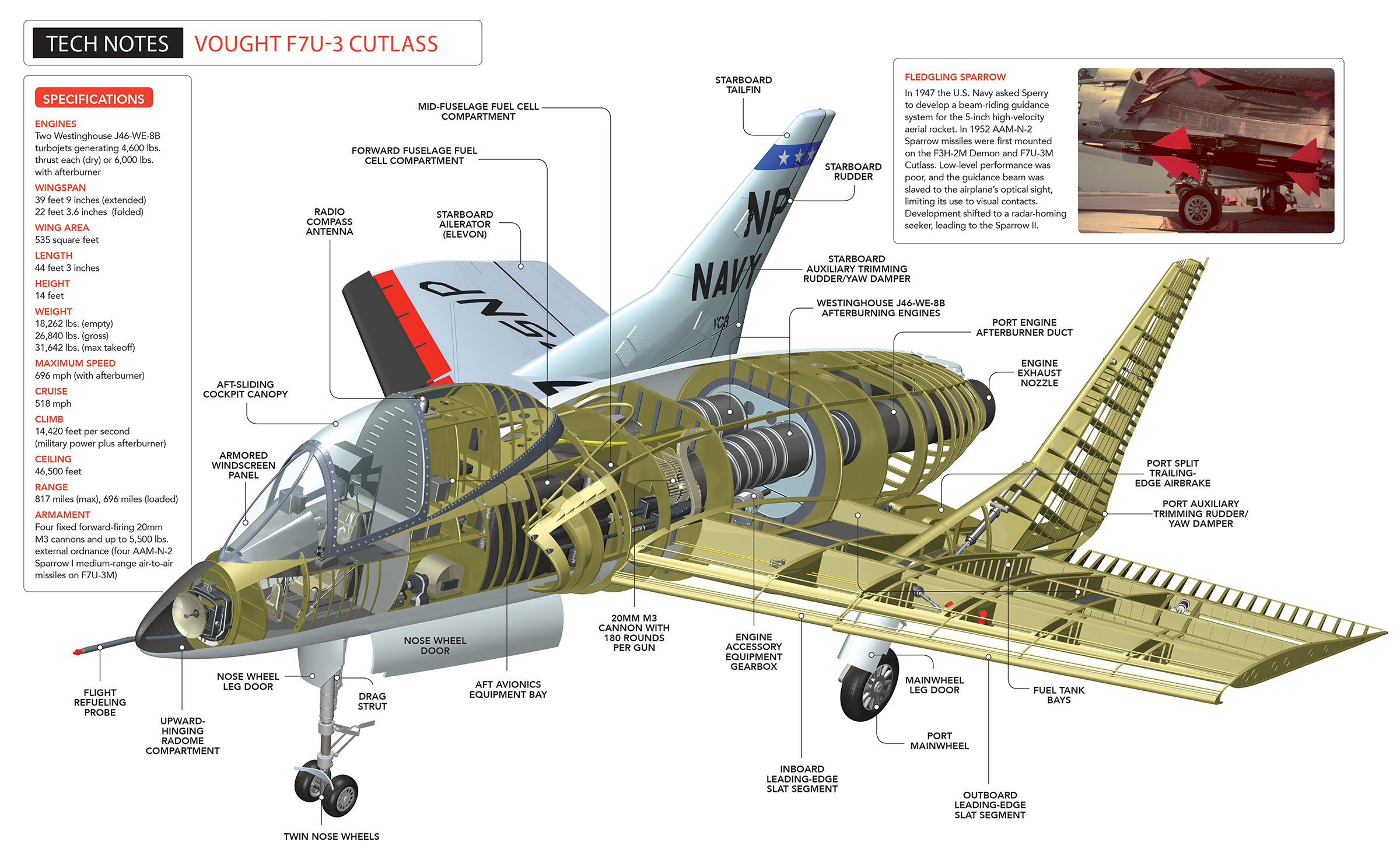
One of the toughest problems the pilots encountered during testing was the jet’s nasty stall characteristics. Only a very small number of pilots were authorized to experiment in this area, and although Shelton had been pushing the dash-3 up to the stall point, he wasn’t permitted to take it further. “For several flights, I had made a few gentle approaches to stall in the clean configuration,” said Shelton. “At that point, I just relaxed the controls and let the aircraft fly out of the approach to stall. I did not like what I was experiencing in terms related to classic stalls. Knowing I was not allowed in this area, I called a friend in Flight Test who was very knowledgeable about the Cutlass and related to him what I had been experiencing. Not once had I popped the stick forward in the approach to stall, but rather let the aircraft sort of wallow out of it.
The Ensign eliminator
“Not long after passing this info on, one of the ST pilots did pop the stick forward, putting him in a post-stall gyration from which he could not recover. He safely ejected just south of Pax near Point Lookout. At the time, I was in a process of moving from Service Test over to Project Cutlass at Miramar. For a while, there was a general hold on doing any demo jet aircraft spins until further notice. By the time I got to Chance Vought in January 1954, en route to Miramar, their chief test pilot, John McGuyrt, had repeated the post-stall gyration, including ejection. One of our most experienced pilots, Tag Livingston, was brought to Chance Vought to officially witness a demo program hurriedly set up by Pax and the Bureau of Aeronautics, the Navy’s material-support organization for all naval aviation. This demo established that the Cutlass would not fail structurally during the post-stall gyration, and that the best, maybe only, recovery technique once in the gyration was to put the stick just a bit aft of neutral—no lateral or rudder input—hang on and the aircraft would recover nicely.”
In looking back over his years test-flying the F7U-3, Shelton vividly recalled several incidents. “One of these involved Po Harwell on his first flight being chased by Wally Schirra,” he said. “They took off from Moffett. When Po barely got over the bay at the north end of the field Wally told Po he was on fire and to eject. Total flying time was approximately one minute. Then there was an ensign from VF-151 on a tactics hop who maneuvered into an accelerated stall and the post-stall gyration ensued. For some reason he did not apply the correct recovery technique and ejected.
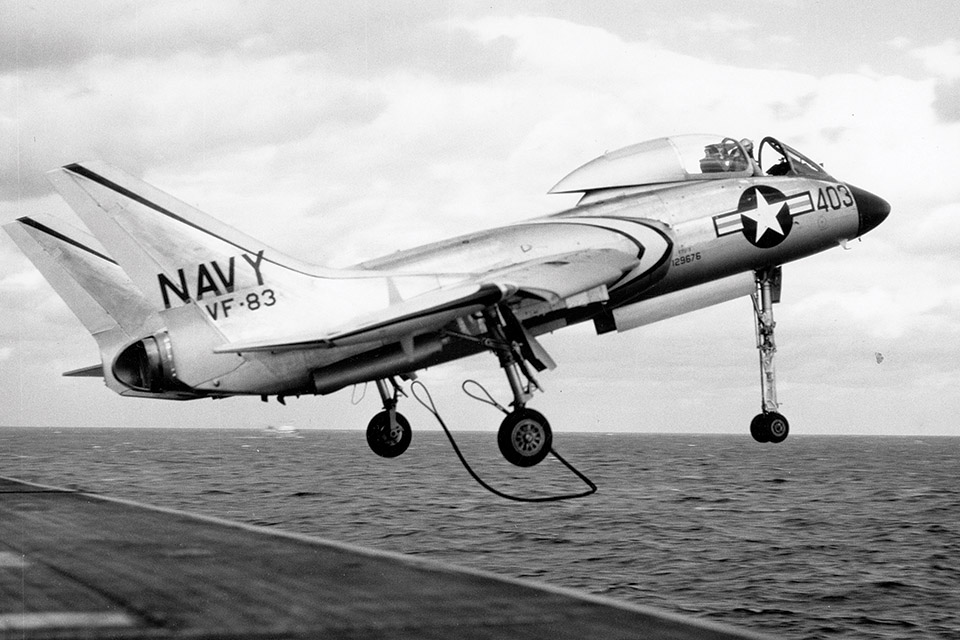
“Then there was Bud Sickel, who had argued with me over and over that the F7U-3 was just like any other aircraft in that it would spin and standard spin recovery techniques would work. One day in late 1955, when I was in San Diego on TAD [temporary additional duty], Bud elected to prove his argument. Over around Crowes Landing, Bud intentionally got a stall clean at about 15,000 feet, got into the post-stall gyration, tried everything except the correct recovery technique and ejected so low that he and the seat hit the ground only a few feet apart, with the aircraft landing close by also. He survived but that was the end of the argument. On another occasion Bud and I were lined up for takeoff on 32L at Moffett behind an F7U-3 that was flown by a pilot from VF-151. As he started his takeoff run, his left engine exploded, and about halfway down the runway he stopped the aircraft directly in front of the fire station. The pilot exited safely but the aircraft was burned to a crisp, which left an F7U-3 imprint about 12 inches deep in 32L, an asphalt runway.”
Lieutenant j.g. Robert O. Angle, another pilot involved with testing the Cutlass, had the opportunity to fly the F7U-3 in an operational trial with VF-124 aboard USS Hancock during a Far East cruise. He had just finished advanced flight training, so it would be his first squadron assignment. Prior to completing his training, he was told to report to the CO’s office. His mind raced over all the things he might have done wrong, including accidentally flying into Mexican airspace. “To my great surprise and relief, that errant flight had nothing to do with my being called to his office,” Angle said. “My CO told me that a squadron at NAS Miramar was getting a new and controversial fighter that many thought would be too much for a new pilot to handle. At that point, he asked me how I felt about going to a squadron like that. I knew right away he was talking about the F7U-3 Cutlass, and I immediately told him I wanted to go. I would be one of only a few pilots assigned to VF-124 to go from flight training to the new sweptwing Cutlass.”
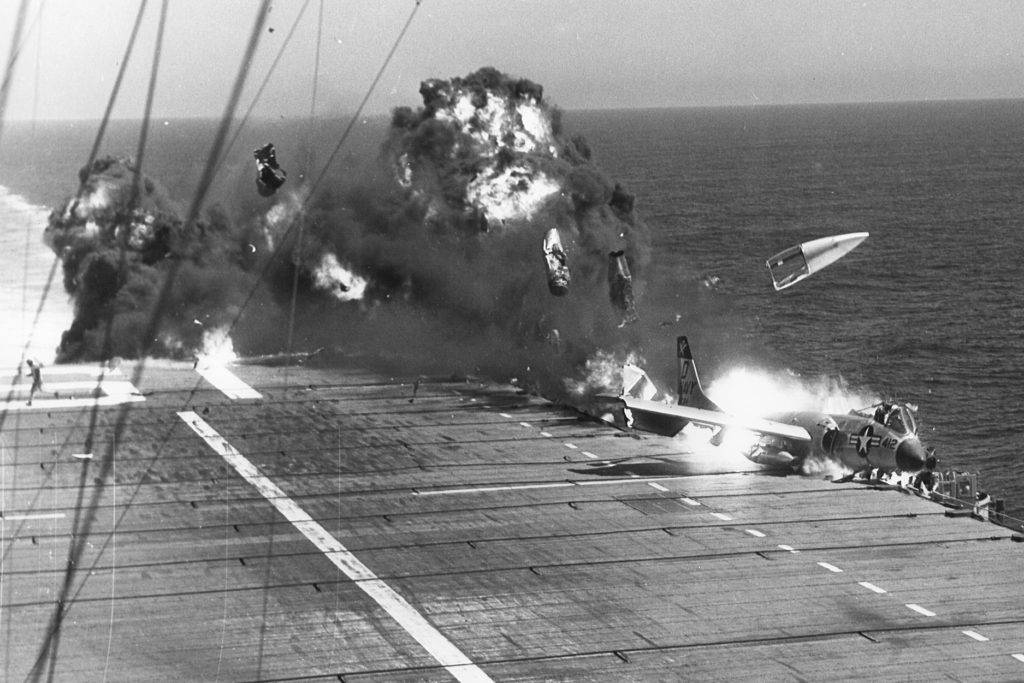
Before Angle could get into the cockpit, he had to undergo extensive ground education classes on the Cutlass’ systems and flight characteristics. In about the third week of indoctrination, one of the recent new pilots was killed on his first flight in the F7U-3. Soon after crossing the coast north of La Jolla at about 5,000 feet, the aircraft went into a tight spiral and flew directly into the ocean. The doomed pilot did not communicate with his chase plane and did not eject. “After the accident, the skipper talked to each of us that had not yet had a first flight in the Cutlass to see if we wanted in the program or be transferred out,” Angle recalled. “All of us elected to stay. For me, it was not a difficult decision because the pilots who had flown the Cutlass praised its handling characteristics and told us that it handled just like other fighters, except better! I was not afraid of it and was eager to get started.”
After that accident, the Cutlasses in VF-124 were grounded while Vought engineers tried to figure out what had happened. The debris from the wreck, recovered from the ocean floor, yielded no evidence of a mechanical failure. One possible explanation was that the pilot inadvertently moved the roll trim control at the top of the stick, causing a sharp bank that initiated the spiral. Angle explained: “Unlike the jets we had flown in flight training—the TV-2 two-seater and the F9F Panther, which used a single button on top of the control stick for pitch and roll trim—the Cutlass had two rheostat-type trim wheels on the stick: one for roll and one for pitch. In a stressful situation, we speculated that the pilot placed his left hand on top of the stick, accidentally touching the roll trim wheel and moving it slightly. Only a couple of degrees of movement would have been enough to start a quick roll.”
Underpowered overachiever
Of all the jet designs on the drawing board in the late 1940s, the F7U appeared to hold the greatest potential for supersonic flight—it just looked fast, even on the ground. But despite its twin engines, the Cutlass possessed too little thrust and too much bulk to break the sound barrier. Above 30,000 feet, it could reach approximately Mach .98 or .99 in level flight with afterburners, and in a power dive with full afterburner the Mach meter would probably indicate 1.0, but that was about as far as it got. The entire reason for the Cutlass’ being was its armament and ordnance capabilities.
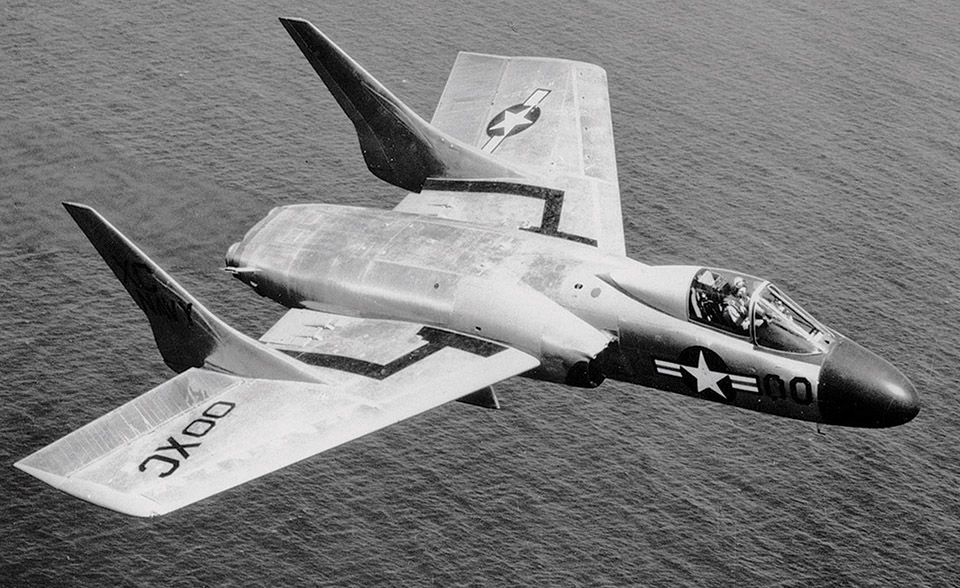
“Armament for the F7U-3 consisted of four 20mm cannons mounted above the engine intakes, an attachable rocket pack and external stores carried on the wing pylons,” explained Angle. “The cannon design had caused engine flameout problems, which the experts thought had been solved before VF-124 received the Cutlasses. Vents had been installed in the fuselage above the cannons to prevent propellant gases from being sucked into the engine. Later, an additional fix consisted of installing large lips along the bottom edges of the engine intakes. We had limited gunnery practice, firing on towed banners, and we experienced no flameout problems. The lips probably reduced top speed slightly, but we did not notice any changes.
“The rocket pack contained 16 rows for 32 2.75-inch nonguided solid-propellant rockets. Two rockets in each row meant that one was in front of the other and that they had to be fired in sequence, with the front ones departing first. The tube fronts were covered by a retractable cover during flight, and the firing sequence was supposed to open the cover an instant before rockets were fired. Unfortunately, the design was defective: Sometimes the cover did not open and rockets were propelled into it. Then there were incidents where the first row would misfire and the one behind it would be trapped and burn itself out. This happened to me once, but the trapped rocket did not burn through the fuselage skin and I landed without being aware of the problem. Chance Vought and the Navy came up with a ‘fix’ for the problem. They simply installed a stainless steel plate between the top of the rocket pack and the Cutlass’ fuselage.”
With Cold War tensions on the rise during the early 1950s, any new American aircraft was expected to be capable of carrying sophisticated “special” weapons. The ability to deliver nuclear weapons was no longer limited to the big bombers flown by Strategic Air Command. Carrier-based attack aircraft had come of age and were prime candidates to add this capability to their resumes. The Cutlass was no exception.
Angle explained: “Our aircraft were equipped with the technology to arm a nuclear weapon in flight and to deliver it either during a half-loop starting at ground level or during a vertical dive starting at high altitude. The long main landing gear struts provided adequate ground clearance for the size of bombs we were to carry. A primitive computer system with a panel display similar to an ILS [instrument landing system] display guided the pilot and released the weapon in a half-loop delivery. The technique involved flying at about 50 feet above the ground at maximum speed, then pulling up into a 4G loop over the target.” Fortunately, no pilot ever had to perform that “toss-bombing” maneuver in combat.
On the surface, the futuristic Cutlass appeared to possess all the necessary traits to make it a great fighter. But its anemic engines, poor carrier takeoff and landing performance and the numerous accidents it suffered eventually signaled its death knell. The Blue Angels briefly flew two F7U-1s as a side demonstration during their 1953 shows, but the jet’s fanfare would be short lived. The Cutlass was retired from service in March 1959, replaced by a far more capable Vought fighter, the F8U/F-8 Crusader.
Frequent contributor Warren Thompson specializes in military aviation from World War II through Desert Storm. For additional reading, he recommends: Chance Vought F7U Cutlass, by Steven Ginter; and Chance Vought F7U-1 Cutlass, by Tommy Thomason.
Vought’s Visionary Fighter appeared in the September 2016 issue of Aviation History Magazine. Subscribe today!
Want to build your own Cutlass? Click here!

